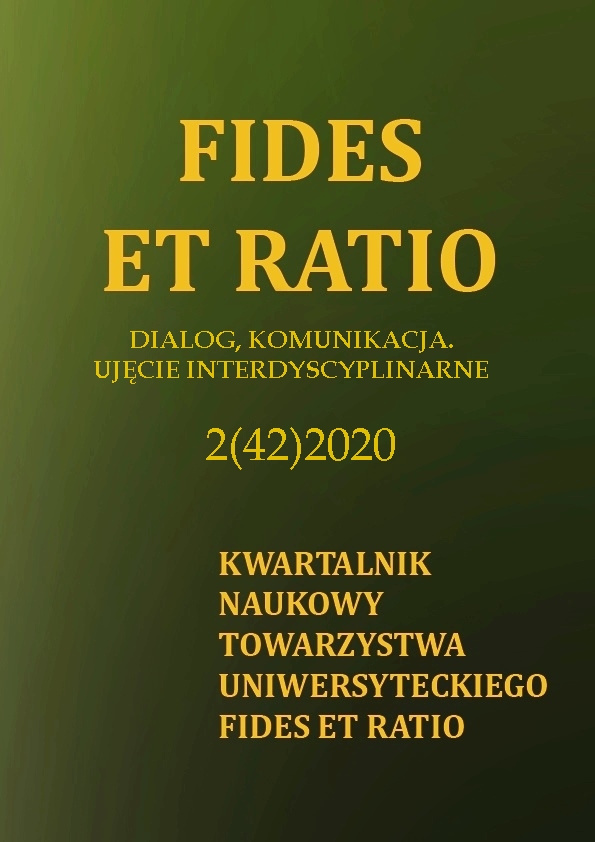Abstract
Abstract: Many different definitions are assigned to interpersonal communication. Regardless of their multiplicity interpersonal communication can be divided into verbal and non-verbal. In the first type, words play the most important role (both spoken and written) while in the second - body language which includes gesticulation, eye contact, touch, physical distance, sounds (paralanguage), way of speaking, body position and facial expressions. Some sort of facial expressions are micro-expressions which lasts fractions of a second. To better understand this phenomenon, they the subject of basic emotions that occur naturally in all cultures is touched on. Micro-expressions are so short that it is very difficult to register consciously. For this reason, the Facial Action Coding System (FACS) is used to have a second look on them. Micro-expressions may be useful in clinical, political and broadly understood security.
References
Barrett, L. F., Adolphs, R., Marsella, S., Martinez, A. M., & Pollak, S. D. (2019). Emotional expressions reconsidered: Challenges to inferring emotion from human facial movements. Psychological Science in the Public Interest, 20, 1–68.
Chodkowski, Z. (2017). Zarys charakterystyki komunikacji interpersonalnej – możliwe zakłócenia i bariery. Kultura – Przemiany – Edukacja, 5, 282 – 294.
Chmielowska – Marmucka, A., Górska, B. (2015). O komunikacji werbalnej, niewerbalnej i wokalnej wymianie sygnałów w kontekście edukacyjnym. Problemy współczesnej pedagogiki, 1 (1), 25 - 39.
Dolińska, D. (2013). Mowa ciała jako aspekt komunikacji międzyludzkiej. Zeszyty Naukowe Politechniki Śląskiej. Organizacja i Zarządzanie, 65, 101 – 110.
Ekman, P., Friesen, W., V. (1969). Nonverbal Leakage and Clues to Deception. Psychiatry, 32, 88 – 105.
Ekman, P. (1997). Kłamstwo i jego wykrywanie w biznesie, polityce, małżeństwie. Warszawa: Wydawnictwo Naukowe PWN.
Ekman, P. (2012). Emocje ujawnione. Gliwice: Helion.
Frank, M., G., Ekman, P. (1996). Physiologic effects of the smile. Directions in Psychiatry, 16 (25), 1 – 8.
Frączek, A. (2012). Komunikacja interpersonalna. Studia Gdańskie. Wizja i rzeczywistość, 9, 118 – 131.
Jenkins, L. (2017). Angry faces may capture attention but do they hold it? Madridge Journal of Neuroscience, 1 (1), 7 – 16.
Kulczycki, E. (2012). Teoretyzowanie komunikacji. Poznań: Wydawnictwo Naukowe Instytutu Filozofii UAM.
Lewczuk, J. (2007). Rozpoznawanie mimicznej ekspresji emocji. Nowiny psychologiczne, 9, 5 – 32.
Łosiak, W. (2015). Emocja jako komunikat. Poznańskie Studia Slawistyczne, 9, 319 – 331.
Maćkiewicz, J. (2008). Jak mówimy o mówieniu, czyli językowy model komunikacji werbalnej. Język a kultura, 20, 211 – 223.
Matsumoto, D., Hwang, H., C. (2018). Microexpressions Differentiate Truths From Lies About Future Malicious Intent. Frontiers in Psychology, 9, 1 – 11.
Mehu, M., Dunbar, R., Little, A., C. (2007). Duchenne smiles and the perception of generosity and sociability in faces. Journal of Evolutionary Psychology, 5 (1 – 4), 133 – 146.
Nęcka, E., Orzechowski, J., Szymura, B. (2006). Psychologia poznawcza. Warszawa: Wydawnictwo Naukowe PWN.
Pfister, T., Zhao, G., Li, X., Pietikäinen, M. (2011). Recognising spontaneous facial micro-expressions. Machine Vision Group, Department of Computer Science and Engineering, University of Oulu.
Williams, L., M., David, A., Senior, C., Loughland, C., M. (2001). In Search of the Duchenne Smile: Evidence from Eye Movements. Journal of Psychophysiology, 15 (2), 122 – 127.
Vick, S., Waller, B.M., Parr, L.A, Smith Pasqualini, M., C., Bard, K., A. (2007). A Cross-species Comparison of Facial Morphology and Movement in Humans and Chimpanzees Using the Facial Action Coding System (FACS). Journal of Nonverbal Behavior, 31, 1–20.
Yan, W.-J., Wu, Q., Liang, J., Chen, Y.-H., Fu, X. (2013). How fast are the leaked facial expressions: The duration of micro-expressions. Journal of Nonverbal Behavior, 37(4), 217–230.
Zięba, A. (2008). Język a kultura. Komunikacja werbalna w wybranych polskich, brytyjskich i amerykańskich programach telewizyjnych. Investigationes Linguisticae, 16, 250 – 263.
Internet sources
